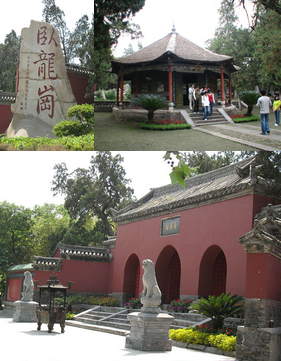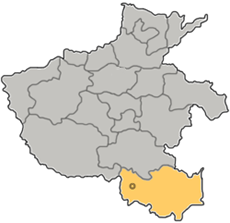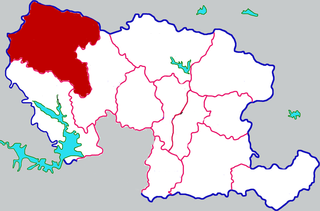
Henan is a landlocked province of China, in the central part of the country. Henan is often referred to as Zhongyuan or Zhongzhou (中州), which literally means "central plain" or "midland", although the name is also applied to the entirety of China proper. Henan is a birthplace of Han Chinese civilization, with over 3,200 years of recorded history and remained China's cultural, economic and political center until approximately 1,000 years ago.

Jade is a mineral used as jewellery or for ornaments. It is typically green, although may be yellow or white. Jade can refer to either of two different silicate minerals: nephrite, or jadeite.

Nanyang is a prefecture-level city in the southwest of Henan province, China. The city with the largest administrative area in Henan, Nanyang borders Xinyang to the southeast, Zhumadian to the east, Pingdingshan to the northeast, Luoyang to the north, Sanmenxia to the northwest, the province of Shaanxi to the west, and the province of Hubei to the south.

Zhumadian is a prefecture-level city in southern Henan province, China. It borders Xinyang to the south, Nanyang to the west, Pingdingshan to the northwest, Luohe to the north, Zhoukou to the northeast, and the province of Anhui to the east.

Sanmenxia is a prefecture-level city in the west of Henan Province, China. The westernmost prefecture-level city in Henan, Sanmenxia borders Luoyang to the east, Nanyang to the southeast, Shaanxi Province to the west and Shanxi Province to the north. The city lies on the south side of the Yellow River at the point where the river cuts through the Loess Plateau on its way to the North China Plain.

Xinyang is a prefecture-level city in southeastern Henan province, People's Republic of China, the southernmost administrative division in the province. Its total population was 6,234,401 according to the 2020 census. As of the 2010 census, 1,230,042 of them lived in the built-up area made of two urban districts, Pingqiao and Shihe.

Nansi Lake, or Weishan Lake, administrated by Weishan County and located in Shandong Province in China, is the largest freshwater lake in the north of the country. It consists of four connected lakes: Weishan, Zhaoyang, Nanyang, Dushan. It is 120 km long and 1266 square km in area.

Wolong District is a District in the center part of Nanyang, in the southwest of Henan province, People's Republic of China. It possesses a total area of 1,017 km2 (393 sq mi), and has a population of 930,000.

Wancheng District is one of two districts of the city of Nanyang, in the southwest of Henan province, People's Republic of China.

Chinese jade refers to the jade mined or carved in China from the Neolithic onward. It is the primary hardstone of Chinese sculpture. Although deep and bright green jadeite is better known in Europe, for most of China's history, jade has come in a variety of colors and white "mutton-fat" nephrite was the most highly praised and prized. Native sources in Henan and along the Yangtze were exploited since prehistoric times and have largely been exhausted; most Chinese jade today is extracted from the northwestern province of Xinjiang.

Jinshui District is one of 6 urban districts of the prefecture-level city of Zhengzhou, the capital of Henan Province, South Central China. The District is 135.3 square km, in which the urban area is 70.65 square km. The total population is 1.4 million.

Fawang Temple is a modern Chinese Buddhist monastery located 5 km (3.1 mi) northwest of the town of Dengfeng in Henan province, China. Situated at the bottom of the Yuzhu Peak of Mount Song, the monastery claims to be the descendant of the second Buddhist monastery constructed in China. However, the type of Buddhism espoused before the revolution was Chan, which had not yet evolved in the time of the monastery's legendary founding.
Nanzhao County is a county under the jurisdiction of Nanyang City, in the southwest of Henan province, China, has an area of 2,946 km2 (1,137 sq mi) and a population of 600,000 as of 2002.

Xixia County is a county in the southwest of Henan province, China, bordering Shaanxi province to the west. It is under the administration of the prefecture-level city of Nanyang, and has an area of 3,452 km2 (1,333 sq mi) and a population of 420,000 as of 2002.
Zhenping County is a county in the southwest of Henan province, China. It is under the administration of the prefecture-level city of Nanyang.
Jingzhou or Jing Province was one of the Nine Provinces of ancient China referenced in Chinese historical texts such as the Tribute of Yu, Erya, Rites of Zhou, and Romance of the Three Kingdoms.
The Nanyang Normal University is an ordinary undergraduate college in Henan Province. It was founded in 1951 in Nanyang Normal School of Henan Province. In 1958, it was upgraded to Nanyang Normal College. In 2000, it was upgraded to Nanyang Normal University. In 2007, through the evaluation of the undergraduate teaching level of the Ministry of Education, in 2011, it was approved as the “National Special Needs Talent Training Project – the bachelor degree awarded unit to carry out the training of master's degree graduate students”. In 2016, it was identified as a demonstration application in Henan Province. The technical type of undergraduate colleges was approved in 2017 as a master's degree granting unit.

Kui Mulang is a deity in traditional Chinese spiritual beliefs. He is considered to be one of the 28 Mansions, which are Chinese constellations. These constellations are the same as those studied in Western astrology. Kui Mulang originated from the ancient Chinese worship of the constellations, a spiritual practice that combines Chinese mythology and astronomy.














